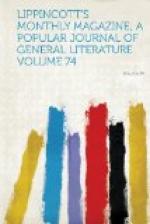Chester is one of the oldest towns on the line of the road by actual years, but one of the youngest in growth. First called by the Indians Mackaponacka, and then by the settlers Upland, it had a justice of the peace court in 1676. Its court-house was built in 1724. Its first newspaper was published in 1819. For many years Chester dozed away in dignified quiet as the county-town: its court-house and jail gave it all the honor it required. But the streams made good mill-sites, the deep waterfront along the river offered splendid wharfage and chances for shipbuilding, and, as good luck would have it, a rivalry awoke which ended in loading Media with the county buildings and relieving Chester. Since then it has doubled and trebled: mills and factories are on all sides, and its shipyards are not easily surpassed. Roach’s shipyard covers twenty-three acres. The firm make their own engines and everything required in iron shipbuilding from keel to topmast. They have six vessels now on the stocks, and employ eleven hundred men, and have room for sixteen hundred. They have built for every trade from the coaster to the East Indiaman, varying in size from six hundred to four thousand tons, and their vessels pass unchallenged amongst the best in the world.
[Illustration: View of Chester.]
Nor is trade the only feature of the town. About half a mile from the depot, on a gentle eminence, is the Crozer Theological Seminary. The approach from Chester for the pedestrian, along the shrub-, vine- and tree-clad banks of Chester Creek into and across the wide lawn, is a delightful walk. The principal building was erected by John P. Crozer for a normal school. During the war he gave it to the government for a hospital, and when he died in 1866 left it to his sons, desiring them to devote it to some benevolent use. They have responded in a munificent manner by establishing a school for training young men for the ministry, with accommodations for a hundred students, houses for the professors, a church, a library building, lecture-halls and all the required conveniences for a great and successful school. They have added an endowment fund of two hundred and twenty-eight thousand dollars, the whole gift being about three hundred and ninety thousand dollars, and one of the family has since given twenty-five thousand dollars as a library fund. The seminary was opened in 1868 with fifteen students: there are now fifty from all parts of the Union.
[Illustration: Residence of Mr. F.O.C. Darley.]
But the most complaisant conductor of the most accommodating special train could not wait any longer for us, and we must hurry on through Lamokin, where the Baltimore Central, a tributary road, turns off and traverses a most picturesque country, round by Port Deposit to Perryville, where it again reaches the main road. At Lamokin are works where steel of a peculiar kind is manufactured under a European patent. From here the road again clings to the shore of the Delaware, and until we reach Wilmington the river, with its sails and its blue water, is on the left—on the right a high ridge, which ends in the valley of the Shell Pot and Brandywine at Wilmington.




